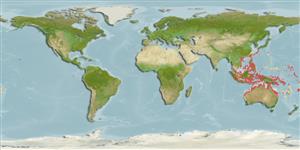Common names from other countries
Environment: milieu / climate zone / depth range / distribution range
Écologie
marin; saumâtre récifal; profondeur 2 - 20 m (Ref. 48637). Tropical; 30°N - 31°S, 99°E - 175°W
Western Pacific: Borneo, Philippines, and northwest Australia to Samoa, north to the Ryukyu Islands, south to New South Wales, Australia and Tonga.
Taille / Poids / Âge
Maturity: Lm ? range ? - ? cm
Max length : 31.0 cm TL mâle / non sexé; (Ref. 9710)
Épines dorsales (Total): 0; Rayons mous dorsaux (Total): 9-11; Épines anales 0; Rayons mous anaux: 9 - 10. Body covered with prickles. Many longitudinal dark stripes on body, although the stripes sometimes faint (Ref. 559).
Inhabits muddy substrates, usually shallow coastal slopes to about 20 meters depth and in shallow estuaries (Ref. 48637). Occurs in estuaries, sheltered reef flats, and lagoons to a depth of more than 17 m. Common in seagrass beds and sandy areas; juveniles found among mangroves (Ref. 1602). Benthopelagic (Ref. 58302).
Life cycle and mating behavior
Maturité | Reproduction | Frai | Œufs | Fécondité | Larves
Myers, R.F., 1991. Micronesian reef fishes. Second Ed. Coral Graphics, Barrigada, Guam. 298 p. (Ref. 1602)
Statut dans la liste rouge de l'IUCN (Ref. 130435)
CITES (Ref. 128078)
Not Evaluated
Menace pour l'homme
Harmless
Utilisations par l'homme
Plus d'informations
RéférencesAquacultureProfil d'aquacultureSouchesGénétiqueElectrophoresesHéritabilitéPathologiesTraitementMass conversion
CollaborateursImagesStamps, Coins Misc.SonsCiguateraVitesseType de nageSurface branchialeOtolithesCerveauxVision
Outils
Articles particuliers
Télécharger en XML
Sources Internet
Estimates based on models
Preferred temperature (Ref.
115969): 25 - 29.3, mean 28.5 (based on 2174 cells).
Phylogenetic diversity index (Ref.
82804): PD
50 = 0.5000 [Uniqueness, from 0.5 = low to 2.0 = high].
Bayesian length-weight: a=0.02630 (0.01523 - 0.04541), b=2.85 (2.71 - 2.99), in cm Total Length, based on LWR estimates for this species & Genus-body shape (Ref.
93245).
Niveau trophique (Ref.
69278): 3.8 ±0.0 se; based on diet studies.
Résilience (Ref.
120179): Haut, temps minimum de doublement de population inférieur à 15 mois (Preliminary K or Fecundity.).
Fishing Vulnerability (Ref.
59153): Low vulnerability (21 of 100).
